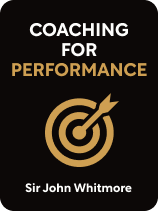

This article is an excerpt from the Shortform book guide to "Coaching for Performance" by Sir John Whitmore. Shortform has the world's best summaries and analyses of books you should be reading.
Like this article? Sign up for a free trial here.
Want to know how to assess organizational culture? What tools can performance coaches use?
According to Sir John Whitmore, it’s important to assess organizational culture and your impact on it as a performance coach. In Coaching for Performance, he provides valuable assessment tools to help performance coaches achieve this goal.
Read on to learn how to assess organizational culture as a performance coach, according to Whitmore.
How to Assess Organizational Culture
As a pioneer of workplace coaching and co-creator of the popular GROW model, a coaching framework for goal-setting and performance improvement, Sir John Whitmore has made a name for himself in the realm of performance coaching. In addition to explaining the new benefits of performance coaching, Coaching for Performance, the 5th edition of Whitmore’s groundbreaking 1992 book, offers updated information on how to assess organizational culture as a performance coach.
In this article, we’ll discuss how to assess organizational culture, according to the advice that Whitmore offers to performance coaches.
Measuring Culture and Performance
Whitmore says that to drive performance, leaders must understand their organization’s culture and its impact on performance and, as the performance coach, you must understand the impact of your work on company performance. To assess organizational culture, you can use Whitmore’s Performance Curve, while his Return on Investment (ROI) methodology can be used to measure the impact of your performance coaching.
(Shortform note: Although “performance curve” and “return on investment” are common terms in many industries, here we’re referring to the specific assessment tools Whitmore developed.)
The Performance Curve
The Performance Curve is a tool that helps you to assess organizational culture. It outlines four stages of organizations’ cultural development and corresponding levels of performance that coaches and leaders should assess. Workers’ motivating force at each stage in the Performance Curve corresponds to the needs that drive people at each level on Maslow’s hierarchy of needs.
Stage 1: Impulsive. This stage is characterized by structureless chaos, inconsistency, and short-term thinking. Workers are motivated by survival. Performance is low.
At this stage, coaches should focus on raising team members’ self-awareness and awareness of others in the company and encourage them to be responsible for their work.
Stage 2: Dependent. This stage is characterized by a command-and-control mode of operation, low trust in authority, compliance, and risk aversion. Workers are motivated by the need to belong. Performance is low to medium.
At this stage, coaches should focus on empowering and encouraging team members to take greater ownership of their work.
Stage 3: Independent. This stage is characterized by structures that support individual workers’ and leaders’ goals and workers’ sense of autonomy, ownership, and drive to succeed. Workers are motivated by esteem. Performance is medium to high.
At this stage, coaches should focus on broadening team members’ perspectives beyond themselves and supporting their collaboration with colleagues.
Stage 4: Interdependent. This stage is characterized by teams running themselves, leaders supporting and inspiring them; strong collaboration, communication, and idea sharing; and a learning-centered culture. Workers are motivated by self-actualization. Performance is high.
At this stage, coaches should shift focus from supporting individual team members to overall team performance.
(Shortform note: Whitmore doesn’t detail how to do this kind of coaching, but experts say one way to support thriving teams is to have them regularly solicit peer feedback to enhance their performance. For example, they can informally ask colleagues, “What can we do even better in the future?” This question keeps input positive, productive, and forward thinking.)
| The Six Stages of the Life and Death of An Organizational Culture Whitmore’s four-stage Performance Curve can be used to assess organizational culture in terms of improvement and growth. In contrast, the Six Stages of Organizational Culture model envisions the full life and death cycle of company cultures, which unfolds as follows: Stage 1: Chaos. This stage is characterized by unpredictable change and instability—the latter driven, in part, by impulsive behaviors of individual workers with little in common and no clear understanding of the organization’s purpose. This stage is similar to the “Impulsive” stage of Whitmore’s Performance Curve, where individuality and inconsistency are high and performance is low. Stage 2: Maturing. In this stage, workers settle into their roles. Individuals become a collective that shares characteristics, emotions, and behaviors. This stage is similar to Whitmore’s “Independent” stage, where individual workers understand their role and care about their work. Attunement to the needs and good of the collective have yet to be developed, but performance is relatively high. Stage 3: Thriving. In this stage, the group establishes a culture through a shared belief in the organization and its purpose. New traditions, beliefs, and behaviors flourish. This stage is comparable to Whitmore’s “Interdependent” stage. Individual workers understand their relationship to and impact on the collective. The culture is healthy and self-sustaining. Performance is high. Stage 4: Fracturing. In this stage, the culture peaks, innovation and success wane, and growth stops. The formerly cohesive group begins to doubt the organization and splinters. Stage 5: Deterioration. In this stage, once-shared ideologies and social structures break down. The culture reverts to factioned interests of individual workers. Stage 6: Obsolescence. In this stage, belief in the organization is dead. The culture reverts to chaos. |
Measure the Return on Investment of Your Performance Coaching
In addition to assessing organizational culture, you can use Whitmore’s ROI to measure the effectiveness of your performance coaching work at maximizing coachees’ potential and performance and changing organizational culture. This allows you to see the effectiveness and benefits of your performance coaching. Follow three steps:
Step 1: When you begin work with your coachee, record—and have them record—the following information:
- Their short and long-term goals
- Actions they’ll take to achieve their goals
- Reflections on their progress toward their goals
Step 2: Estimate the ROI. At the end of your coaching relationship, take the information you gathered from Step 1 and connect them to quantitative results of your coachee’s efforts and the organization’s financial bottom line. List:
- The coachee’s completed actions or tasks
- The monetary impact of each action or task
- Your confidence (from 1% to 100%) in your monetary impact estimate
- Multiply the monetary impact by your confidence level
- Divide that figure by the cost of your coaching
- Multiply your result by 100
| Alternate ROI Measurements Some experts say too much emphasis has been placed on assessing the financial ROIs of coaching work. They recommend instead examining the impact of your investment in coachees. Estimate this in the following ways: 1. Feedback ROI: Measure your coachee’s response to, and application of, input from others about their performance to assess whether they’ve become more receptive to feedback. 2. Motivation ROI: Measure your coachee’s drive in both their current job and pursuit of career dreams. This measure looks broadly at motivation and can reveal what traditional metrics do not: Why one coachee is highly motivated and another is not. 3. Happiness ROI: Measure your coachee’s happiness in and outside of work to assess their emotional state. This information can help companies identify interventions that increase happiness and, thus, productivity. |

———End of Preview———
Like what you just read? Read the rest of the world's best book summary and analysis of Sir John Whitmore's "Coaching for Performance" at Shortform.
Here's what you'll find in our full Coaching for Performance summary:
- A guide on the ins and outs of performance coaching
- Strategies to maximize employees’ potential and performance
- How to measure organizational culture and the impact of your work






